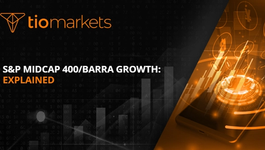Incremental capital-output ratio: Explained
BY TIOmarkets
|July 29, 2024The incremental capital-output ratio (ICOR) is a crucial concept in the world of trading and economics. It provides a measure of a country's economic productivity and efficiency. The ICOR is a ratio that compares the incremental amount of capital needed to achieve an additional unit of output. This concept is vital for traders as it can provide insights into a country's economic health and potential growth.
Understanding the ICOR can be a complex task, as it involves delving into the intricacies of economic theory and practice. However, it is an essential tool for traders who want to make informed decisions based on a comprehensive understanding of a country's economic situation. This article will provide a detailed and comprehensive explanation of the ICOR, its calculation, interpretation, and its implications for trading.
Understanding the Concept of ICOR
The ICOR is a concept that originated from the Harrod-Domar growth model. This model suggests that the growth rate of an economy depends on the level of savings and the capital-output ratio. The ICOR is a modification of this concept, focusing on the incremental changes in capital and output, rather than the overall levels.
The ICOR provides a measure of the productivity of new capital investments. A lower ICOR indicates that less additional capital is needed for each unit of additional output, suggesting a more efficient and productive economy. Conversely, a higher ICOR indicates that more additional capital is needed for each unit of additional output, suggesting a less efficient economy.
Calculation of ICOR
The ICOR is calculated by dividing the change in investment by the change in output. This can be expressed mathematically as ICOR = ΔI/ΔY, where ΔI is the change in investment and ΔY is the change in output. This calculation provides a ratio that represents the amount of additional capital needed to generate an additional unit of output.
It's important to note that the ICOR is a ratio, not a percentage. This means that it can take on any positive value, depending on the changes in investment and output. However, in practical terms, the ICOR is often expressed as a number between 0 and 1, with lower values indicating more productive economies.
Interpretation of ICOR
The interpretation of the ICOR is straightforward. A lower ICOR indicates a more productive and efficient economy, as less additional capital is needed to generate an additional unit of output. Conversely, a higher ICOR indicates a less productive and efficient economy, as more additional capital is needed to generate an additional unit of output.
However, it's important to note that the ICOR is a relative measure. This means that it can only be used to compare the productivity and efficiency of different economies or the same economy at different points in time. It cannot provide an absolute measure of an economy's productivity or efficiency.
Implications of ICOR for Trading
The ICOR has significant implications for trading. Traders can use the ICOR to gain insights into a country's economic health and potential growth. This can help them make informed decisions about their trading strategies.
For example, a trader might choose to invest in a country with a lower ICOR, as this suggests a more productive and efficient economy. Conversely, a trader might choose to avoid investing in a country with a higher ICOR, as this suggests a less productive and efficient economy.
ICOR and Economic Health
The ICOR can provide insights into a country's economic health. A lower ICOR suggests a more productive and efficient economy, which is often associated with stronger economic health. Conversely, a higher ICOR suggests a less productive and efficient economy, which is often associated with weaker economic health.
Traders can use these insights to assess the risks and opportunities associated with investing in a particular country. For example, a trader might choose to invest in a country with a lower ICOR, as this suggests stronger economic health and potentially higher returns. Conversely, a trader might choose to avoid investing in a country with a higher ICOR, as this suggests weaker economic health and potentially lower returns.
ICOR and Economic Growth
The ICOR can also provide insights into a country's potential economic growth. A lower ICOR suggests a more productive and efficient economy, which is often associated with higher potential growth. Conversely, a higher ICOR suggests a less productive and efficient economy, which is often associated with lower potential growth.
Traders can use these insights to assess the growth prospects of a particular country. For example, a trader might choose to invest in a country with a lower ICOR, as this suggests higher potential growth and potentially higher returns. Conversely, a trader might choose to avoid investing in a country with a higher ICOR, as this suggests lower potential growth and potentially lower returns.
Limitations of ICOR
While the ICOR is a useful tool for traders, it's important to be aware of its limitations. The ICOR is a relative measure, which means it can only be used to compare the productivity and efficiency of different economies or the same economy at different points in time. It cannot provide an absolute measure of an economy's productivity or efficiency.
Furthermore, the ICOR is based on the assumption that all other factors remain constant. This is rarely the case in real-world economies, where factors such as technology, labor force, and government policies can significantly affect the productivity and efficiency of capital investments.
ICOR and Other Factors
The ICOR assumes that all other factors remain constant, which is rarely the case in real-world economies. Factors such as technology, labor force, and government policies can significantly affect the productivity and efficiency of capital investments.
For example, advancements in technology can increase the productivity of capital investments, leading to a lower ICOR. Conversely, changes in government policies can decrease the productivity of capital investments, leading to a higher ICOR. Traders need to take these factors into account when using the ICOR to make trading decisions.
ICOR and Absolute Measures
The ICOR is a relative measure, which means it can only be used to compare the productivity and efficiency of different economies or the same economy at different points in time. It cannot provide an absolute measure of an economy's productivity or efficiency.
This means that the ICOR should not be used in isolation. Traders need to consider other measures of an economy's productivity and efficiency, such as the gross domestic product (GDP), the unemployment rate, and the inflation rate. These measures can provide a more comprehensive picture of an economy's health and potential growth.
Conclusion
The ICOR is a crucial tool for traders, providing insights into a country's economic productivity and efficiency. A lower ICOR suggests a more productive and efficient economy, while a higher ICOR suggests a less productive and efficient economy. Traders can use the ICOR to make informed decisions about their trading strategies, assessing the risks and opportunities associated with investing in a particular country.
However, it's important to be aware of the limitations of the ICOR. It is a relative measure and assumes that all other factors remain constant. Traders need to take these factors into account and consider other measures of an economy's productivity and efficiency when making trading decisions. Despite these limitations, the ICOR remains a valuable tool for traders, providing a unique perspective on a country's economic situation.
Start Trading with TIOmarkets
Understanding the incremental capital-output ratio is just the beginning. With TIOmarkets, you can apply your knowledge to the real markets. As a top rated forex broker, we offer a robust online trading platform where you can trade Forex, indices, stocks, commodities, and futures across 300+ instruments in 5 markets. Join over 170,000 traders in 170 countries who have already started their trading journey with us. Enhance your skills with our comprehensive educational resources and step-by-step guides. Ready to put your economic insights into action? Create a Trading Account today and experience trading with low fees and a platform designed for success.

Risk disclaimer: CFDs are complex instruments and come with a high risk of losing money rapidly due to leverage. You should consider whether you understand how CFDs work and whether you can afford to take the high risk of losing your money. Never deposit more than you are prepared to lose. Professional client’s losses can exceed their deposit. Please see our risk warning policy and seek independent professional advice if you do not fully understand. This information is not directed or intended for distribution to or use by residents of certain countries/jurisdictions including, but not limited to, USA & OFAC. The Company holds the right to alter the aforementioned list of countries at its own discretion.
Join us on social media

Behind every blog post lies the combined experience of the people working at TIOmarkets. We are a team of dedicated industry professionals and financial markets enthusiasts committed to providing you with trading education and financial markets commentary. Our goal is to help empower you with the knowledge you need to trade in the markets effectively.





